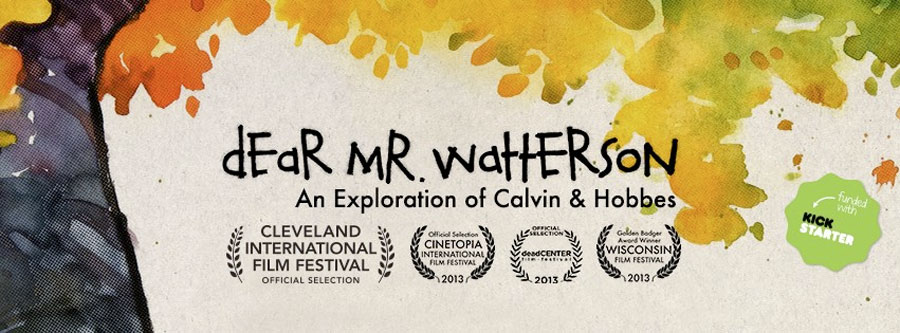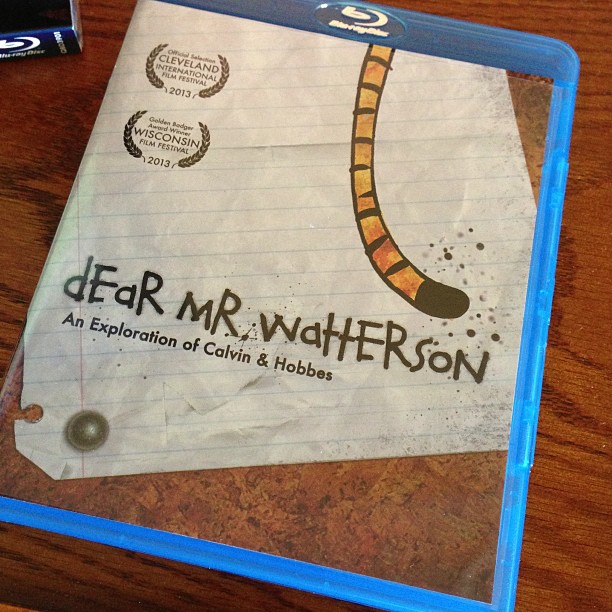‘Dear Mr. Watterson’ Fulfills a Long Kickstarter Journey
Posted 7 years ago by Tim Briscoe Comics, Movies

I enjoy Kickstarter. I take pride in helping subsidize others’ creative goals. It’s even more satisfying when the project closely aligns with my interests and I get a little something in return for my contribution. I’m not rich, mind you—far from it. We’re talking less than $75 with an average of around $10 per project.
I joined the crowd-sourcing website back in early 2010. The first project I backed was Dear Mr. Watterson, a promised “cinematic exploration of Calvin & Hobbes.” I’ve been a huge fan of Bill Watterson’s comic, and newspaper comics in general, for as long as I can remember. The film seemed a worthy first choice to support.
Kickstarter was relatively new when I joined so I didn’t know the negatives inherent to the site. When I contributed to Dear Mr. Watterson, I had no idea I would have to wait nearly three and a half years to see the end product. I pledged my money on Jan. 11, 2010 and finally received a Blu-ray copy of the film in the mail on June 15, 2013. Kickstarter certainly isn’t for people expecting instant gratification.
I’m not really complaining. You see, that’s the other big appeal of Kickstarter. Along with my fellow backers, I received regular updates from director Joel Schroeder on the film’s production. It was interesting to see the progression of the project along with its various challenges. Sharing that journey was rewarding in itself.
But ultimately, I wanted to longed to see the film. Each production update seemed increasingly like a cruel tease given the lengthy wait. I was frankly a little disappointed when the producers premiered the doc in April at the Cleveland International Film Festival. I felt like loyal backers should’ve been rewarded first. That was just a minor annoyance. Again, getting to see the film I helped make possible was the real prize for my contribution.
I settled in and finally watched the movie on Sunday evening. My initial reaction? A decent effort but not outstanding. Pent-up expectations could’ve been part of my problem. A Calvin & Hobbes documentary should be as extraordinary as the comic strip itself, no? Three years is long enough to shine any rough rock to a mirror finish.
The film features the director as he begins his exploration of Calvin & Hobbes and traces his own personal history with the comic. His anecdotes and those of other fans were enjoyable but the cumulative retelling of first C&H encounters became tedious. I know the stranger on the screen loves this six-year-old boy and his stuffed tiger, so do I. Tell me more about them rather than the fans.
Schroeder then traveled to Watterson’s home town in northern Ohio. It was interesting to see how this idyllic small town framed the scenes we all know from the strip. One of several Watterson authorities interviewed for the film was Nevin Martell, author of the “Looking for Calvin and Hobbes” book published in 2010. Martell provided much of Watterson’s back story.
The film also talks with several comic creators that Watterson inspired along with a few of his colleagues including Berkeley Breathed, the man behind Bloom County. I loved this aspect of the documentary. Nothing against the fans but these people’s thoughts and opinions carry more weight. One cartoonist shared his love for the comic and it perfectly matched why I came to love C&H: it was simultaneously the best written and the best illustrated among the busy page of newspaper comics.
Dear Mr. Watterson also delves into the reclusive nature of the creator. Very little is ever seen of the man. One person in the film likened him to that cryptozoological wonder Big Foot. I prefer a different comparison: Bill Watterson makes J.D. Salinger look like Kim Kardashian.
This enigma certainly posed problems for Schroeder and his producers. It’s hard to really examine a subject when its creator refuses true insight. But this is also why I became so interested in the project. I wanted to know—as surely millions of other fans did—why Watterson quit producing the strip in 1995 and why he refused to license his characters for products and animation as contemporaries Peanuts and Garfield had to great success.
Dear Mr. Watterson offered some answers but I craved more. Perhaps if they had truncated the early fan interviews or some footage of Schroeder perusing newspaper archives, they would have had more to devote to these lingering questions. (Speaking of J.D. Salinger, perhaps I’m wanting something similar to the upcoming exposé on that other solitary creative.)
After the film’s credits, there is a small but important scene where Schroeder asked Martell if he ever reached out to Bill Watterson. His negative answer is fitting but left me angry. Why didn’t these guys bother to seek out the man? The film loses quite a bit of integrity when you learn that they didn’t try contacting him. Sure there was a 98% chance the effort would’ve been futile but you have to try for journalism’s sake.
[A relevant sidebar: There’s another prominent Kickstarter film project on the subject of comic strips. The Stripped documentary is general in scope. Naturally I’m also a backer of this forthcoming movie. They just released the first five minutes of footage to supporters. I was shocked to see that the brief clip includes the voice of Watterson speaking on comics.]
I shouldn’t be so hard on the movie. I truly did enjoy it. I hope to check out the disc of bonus features for some lengthy interviews with comic creators I admire like Bill Amend and Dan Piraro. I do recommend watching Dear Mr. Watterson when it becomes available for general purchase. It’s also hitting more regional film festivals this year. See their website for dates.
If I had it to do over again, would I have contributed to this project so long ago? Yes, absolutely. I more than got my money’s worth and helped the filmmakers realize their vision. That’s what Kickstarter is all about.
